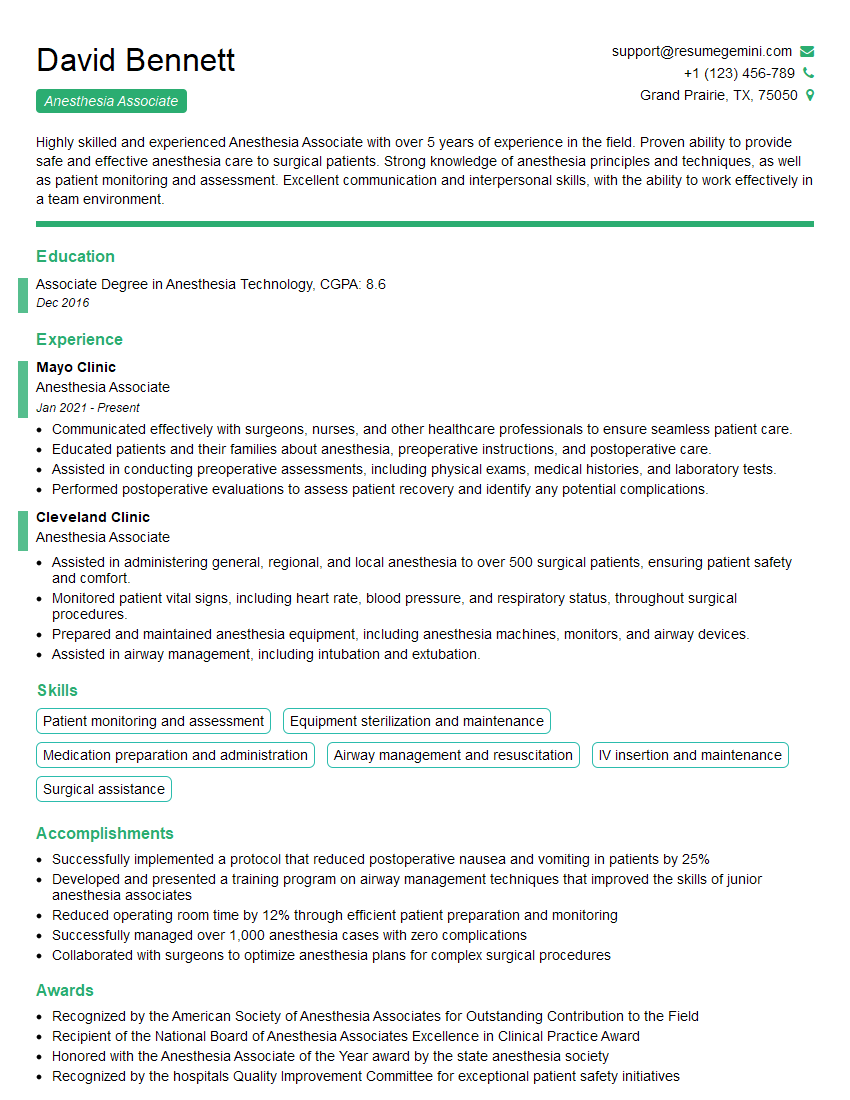Are you a seasoned Anesthesia Associate seeking a new career path? Discover our professionally built Anesthesia Associate Resume Template. This time-saving tool provides a solid foundation for your job search. Simply click “Edit Resume” to customize it with your unique experiences and achievements. Customize fonts and colors to match your personal style and increase your chances of landing your dream job. Explore more Resume Templates for additional options.

David Bennett
Anesthesia Associate
Summary
Highly skilled and experienced Anesthesia Associate with over 5 years of experience in the field. Proven ability to provide safe and effective anesthesia care to surgical patients. Strong knowledge of anesthesia principles and techniques, as well as patient monitoring and assessment. Excellent communication and interpersonal skills, with the ability to work effectively in a team environment.
Education
Associate Degree in Anesthesia Technology
December 2016
Skills
- Patient monitoring and assessment
- Equipment sterilization and maintenance
- Medication preparation and administration
- Airway management and resuscitation
- IV insertion and maintenance
- Surgical assistance
Work Experience
Anesthesia Associate
- Communicated effectively with surgeons, nurses, and other healthcare professionals to ensure seamless patient care.
- Educated patients and their families about anesthesia, preoperative instructions, and postoperative care.
- Assisted in conducting preoperative assessments, including physical exams, medical histories, and laboratory tests.
- Performed postoperative evaluations to assess patient recovery and identify any potential complications.
Anesthesia Associate
- Assisted in administering general, regional, and local anesthesia to over 500 surgical patients, ensuring patient safety and comfort.
- Monitored patient vital signs, including heart rate, blood pressure, and respiratory status, throughout surgical procedures.
- Prepared and maintained anesthesia equipment, including anesthesia machines, monitors, and airway devices.
- Assisted in airway management, including intubation and extubation.
Accomplishments
- Successfully implemented a protocol that reduced postoperative nausea and vomiting in patients by 25%
- Developed and presented a training program on airway management techniques that improved the skills of junior anesthesia associates
- Reduced operating room time by 12% through efficient patient preparation and monitoring
- Successfully managed over 1,000 anesthesia cases with zero complications
- Collaborated with surgeons to optimize anesthesia plans for complex surgical procedures
Awards
- Recognized by the American Society of Anesthesia Associates for Outstanding Contribution to the Field
- Recipient of the National Board of Anesthesia Associates Excellence in Clinical Practice Award
- Honored with the Anesthesia Associate of the Year award by the state anesthesia society
- Recognized by the hospitals Quality Improvement Committee for exceptional patient safety initiatives
Certificates
- Certified Anesthesia Associate (CAA)
- Certified Peri-Anesthesia Nurse (CPAN)
- Advanced Cardiac Life Support (ACLS)
- Pediatric Advanced Life Support (PALS)
Career Expert Tips:
- Select the ideal resume template to showcase your professional experience effectively.
- Master the art of resume writing to highlight your unique qualifications and achievements.
- Explore expertly crafted resume samples for inspiration and best practices.
- Build your best resume for free this new year with ResumeGemini. Enjoy exclusive discounts on ATS optimized resume templates.
How To Write Resume For Anesthesia Associate
- Highlight your experience and skills in anesthesia care.
- Emphasize your patient monitoring and assessment abilities.
- Showcase your knowledge of anesthesia equipment and airway management.
- Demonstrate your communication and teamwork skills.
- Tailor your resume to each specific job you apply for.
Essential Experience Highlights for a Strong Anesthesia Associate Resume
- Assist in administering general, regional, and local anesthesia to surgical patients.
- Monitor patient vital signs, including heart rate, blood pressure, and respiratory status.
- Prepare and maintain anesthesia equipment, including anesthesia machines, monitors, and airway devices.
- Assist in airway management, including intubation and extubation.
- Communicate effectively with surgeons, nurses, and other healthcare professionals.
- Educate patients and their families about anesthesia.
- Perform postoperative evaluations to assess patient recovery.
Frequently Asked Questions (FAQ’s) For Anesthesia Associate
What is the role of an Anesthesia Associate?
An Anesthesia Associate is a healthcare professional who assists anesthesiologists in providing anesthesia care to surgical patients.
What are the educational requirements to become an Anesthesia Associate?
An Associate Degree in Anesthesia Technology is the minimum educational requirement to become an Anesthesia Associate.
What are the key responsibilities of an Anesthesia Associate?
Anesthesia Associates assist in administering anesthesia, monitoring patient vital signs, preparing and maintaining anesthesia equipment, and assisting in airway management.
What are the career prospects for Anesthesia Associates?
Anesthesia Associates can advance their careers by becoming Certified Registered Nurse Anesthetists (CRNAs) or Anesthesiologist Assistants (AAs).
What is the average salary for an Anesthesia Associate?
The average salary for an Anesthesia Associate is around $75,000 per year.
What are the job outlook for Anesthesia Associates?
The job outlook for Anesthesia Associates is expected to grow faster than average over the next few years.
What are some of the challenges of working as an Anesthesia Associate?
Anesthesia Associates may face challenges such as working long hours, being exposed to hazardous chemicals, and dealing with stressful situations.